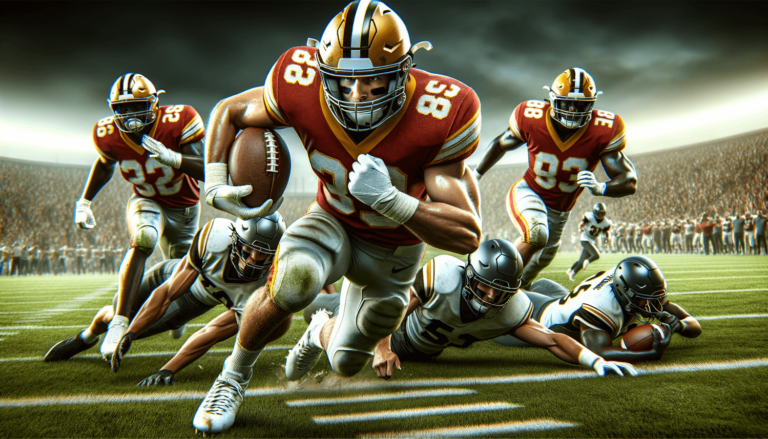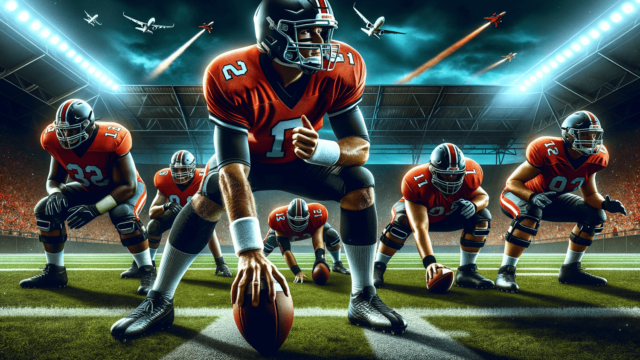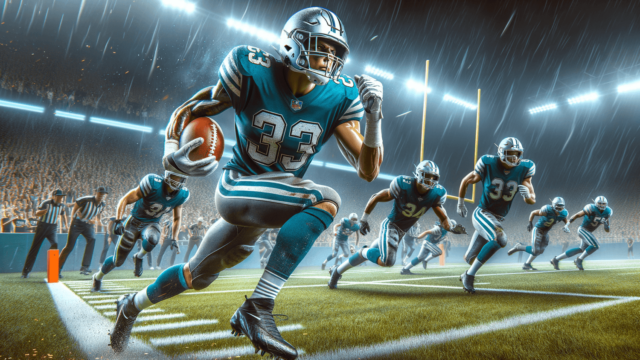
A carry in football refers to the act of a player, typically a running back or quarterback, advancing the ball by running with it rather than throwing or kicking it. Carries are integral to offensive strategies, as they can gain yardage and control possession.
Understanding a Carry in Football
A carry in football is the act of a player, typically a running back or a quarterback, advancing the ball down the field by running with it tucked securely in their arms, as opposed to throwing or kicking it. This central offensive strategy is used to gain yardage and control possession.
Key Positions Involved in Carries
Running Backs
Running backs are versatile players responsible for both running and receiving the ball. They line up behind or beside the quarterback and execute carries after receiving a handoff. They rely on their speed, agility, and vision to find gaps in the defense to maximize yardage.
Quarterbacks
Quarterbacks can also execute carries, usually in the form of a quarterback sneak or a scramble. A sneak occurs when the quarterback quickly moves forward, keeping the ball to exploit a gap in the line. A scramble, on the other hand, happens when the quarterback runs with the ball to evade pressure and gain yardage or find an open receiver.
Types of Running Plays
Inside vs. Outside Runs
Carries can be categorized into inside and outside runs. Inside runs target the space between the offensive linemen, while outside runs aim to exploit the edges of the defense. Depending on the situation and the skills of the ball carrier, coaches choose the most suitable type of run to maximize offensive gains.
Option Plays
An option play grants the quarterback the freedom to decide between carrying the ball himself or pitching it to a running back. Option plays put pressure on defenders, forcing them to commit to tackling either the quarterback or running back. The quarterback’s ability to read the defense is crucial to the success of an option play.
Importance of Carries in Football
Carries serve a vital role in achieving offensive balance. A successful running game can control the clock, wear down the opponent’s defense, and set up a more effective passing game. While the emphasis in modern football has shifted towards the passing game, a consistent run game remains crucial for overall success.
How Offensive Lines Contribute to Carries
Offensive linemen play a critical role in executing carries. These players, including guards, tackles, and centers, form a protective shield around the ball carrier, creating space for them to advance. By opening gaps and neutralizing defensive players, the offensive line can increase the likelihood of successful carries.
Defending Against Carries
Defensive teams have various strategies to counter carries, such as different alignments and certain player assignments. Linebackers, defensive linemen, and defensive backs work in harmony to contain, disrupt, and ultimately prevent the ball carrier from gaining valuable yards.
Statistical Measures for Carries
Rushing Yards
Rushing yards measure the total distance gained on carries by a player or a team during a game. This metric is pivotal for evaluating individual and team performances in terms of ball advancement and successful running plays.
Yards per Carry (YPC)
Yards per Carry (YPC) is a metric that represents the average number of yards a player gains per carry. This statistic helps gauge a player’s efficiency and provides a better understanding of their consistency as a ball carrier. Elite running backs typically average around 4 to 5 YPC.
Notable Running Backs in NFL History
Some of the most successful and celebrated running backs in NFL history have been defined by their ability to carry the ball effectively. Legendary runners like Emmitt Smith, Walter Payton, and Barry Sanders have displayed exceptional skill in rushing and have etched their names in NFL record books.
Rules and Regulations Pertaining to Carries
Carries are subject to specific rules and regulations, such as ball security and forward progress. Players executing carries must secure the ball to avoid fumbles, while forward progress rules grant the ball carrier a forward spot when tackled, even if they are pushed backward as they fall.
FAQ Section: Carries in Football
This FAQ section aims to address some of the most frequently asked questions about carries in football. These questions and answers provide greater insight into the strategies, rules, and performances discussed in this blog post.
What determines a successful carry in football?
A successful carry relies on various factors, including effective blocking by the offensive line, the ball carrier’s vision and agility, the play’s design, and the execution of strategic moves to exploit gaps in the defense.
What role do wide receivers play in a run-oriented offense?
Wide receivers contribute to a run-oriented offense by blocking defensive backs, helping clear the path for ball carriers. They may also run decoy routes to lure defenders away from the ball, creating additional space for the ball carrier to advance.
What are key factors in stopping a carry on defense?
Defensive players must maintain gap discipline, pursue and tackle the ball carrier effectively, and diagnose offensive plays to counter running efforts. Stringent teamwork among defensive linemen, linebackers, and defensive backs is necessary to prevent substantial gains in yardage.
How does a strong running game complement the passing game?
A strong running game forces defensive players to focus on stopping the run, often resulting in additional defenders near the line of scrimmage. This opens up opportunities for passing plays by creating mismatches and more space for wide receivers and tight ends to maneuver.
Can a player other than a running back or quarterback carry the ball?
Yes, players such as wide receivers, tight ends, and occasionally even offensive linemen can carry the ball in specific strategic plays like reverses, end-arounds, or trick plays. However, these situations are less common and typically designed to catch the opposing defense off-guard.
Featured Posts
- No pillar pages found.





